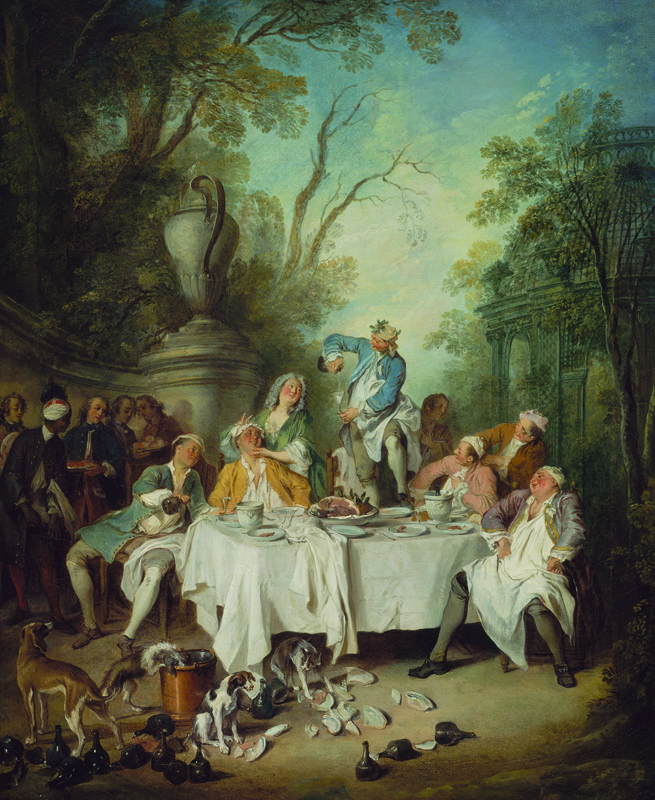
Some 350 years ago, several French cooks championed the same issues as many of today’s great chefs: freshness, delicate flavors, healthy and delicious recipes, and an emphasis on locally grown ingredients. The fascination with food that so grips us now also predominated in the 1700s. Nicolas de Bonnefons described it perfectly. He was a French gardener, valet to Louis XIV, and the author of two important books: the first on gardening, followed by one on cooking called Les delices de la campagne . . . (The Delights of the Countryside). He declared (in translation), “Of all the senses, there is nothing more delicious, nor more necessary to life than that of taste.”
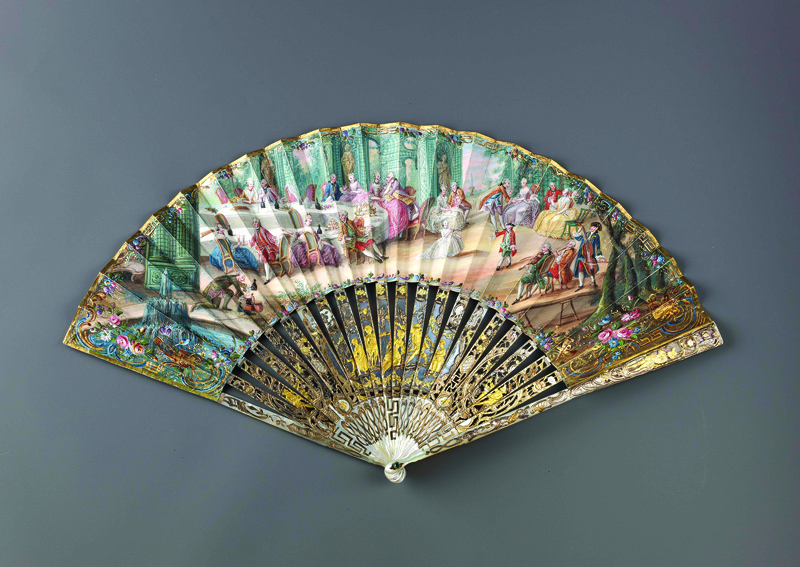
Prior to the 1600s, cooks were largely restricted to ingredients in their natural growing locations and seasons, supplemented by spices and novel imported foods available to the wealthy. Kitchen technology had not advanced since the Middle Ages; most food was cooked over open fires with little or no control of temperature. Hosts demonstrated their elevated status and wealth with grand and formal meals featuring expensive ingredients and complex recipes, regardless of the overall flavor. Food was served on plates, bowls, and platters made of wood, pewter, faïence, silver, or gold, depending on rank.
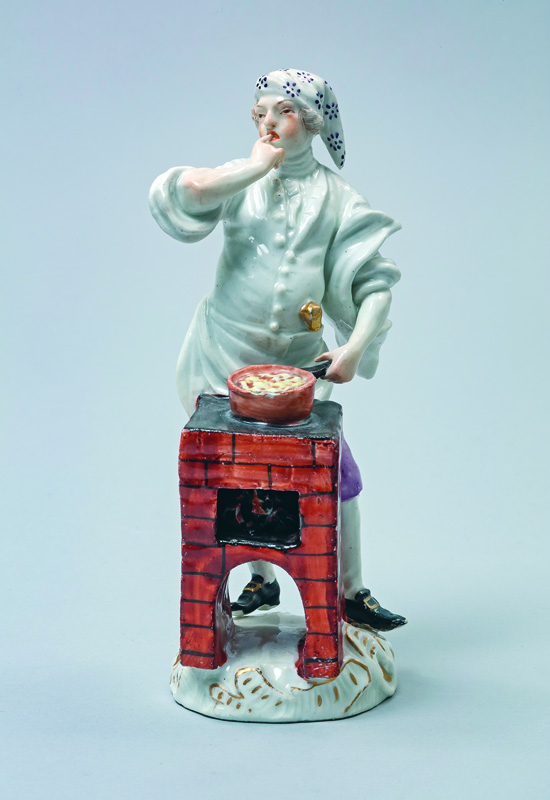
With the dawning of the Age of Enlightenment (around 1650), radical changes were slowly introduced in France and spread triumphantly through fashionable Europe, continuing even now to influence what many of us eat, how we cook, and how we dine. Through the publication and translation of the cookbooks by key French cooks such as François Pierre de La Varenne, Vincent La Chapelle, Menon, and François Marin, cooking in the French style came to dominate taste. Even in Italy, greatly respected for its gastronomy, French cuisine reigned supreme in the 1700s. When Giacomo Casanova was entertained to “a choice and delicious dinner” by his mistress in Venice in 1753, he exclaimed that “the cook must be French, and she said I was right.”2 However, it was not until the 1800s that French cooks such as Marie-Antoine Carême and Auguste Escoffier gained the “celebrity chef” recognition that some chefs enjoy today.
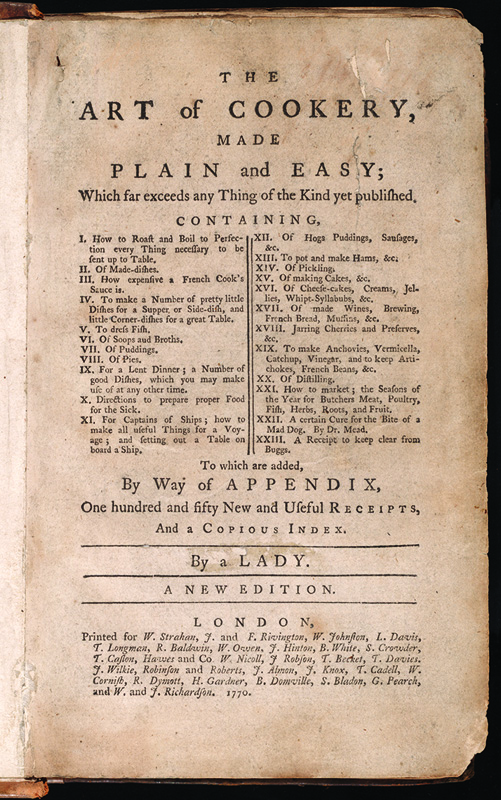
It is curious that male cooks dominated in France, while in England a number of important cookbooks were written by women. Chief among them was Hannah Glasse, whose The Art of Cookery Made Plain and Easy was first published anonymously in 1747 and went through at least thirty editions over the next hundred years (Fig. 4). Despite her efforts, expensive French cooks replaced many English ones in wealthy households as the century progressed, and the fashion for French cuisine spread.
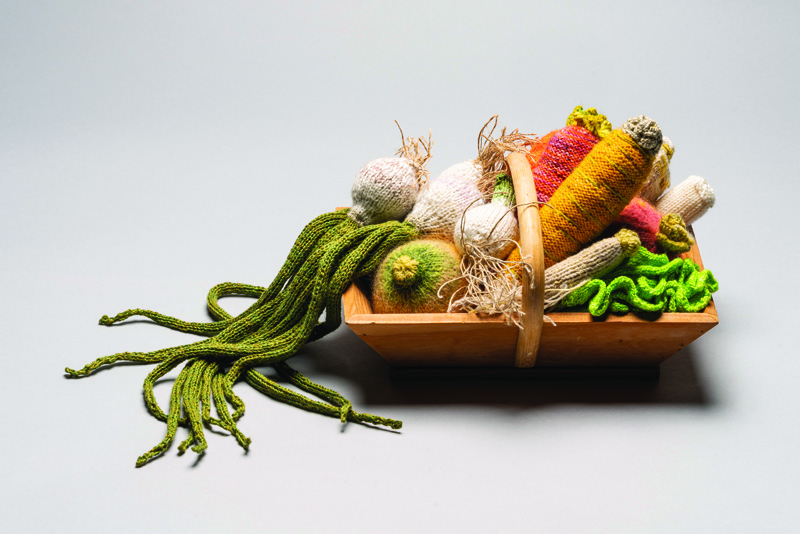
The ephemeral pleasures of food had become such a passion that even princes tried their hands as amateur cooks. For instance, Louis XV had a small kitchen in his newly created petits appartements at Versailles and is said to have rustled up an omelet for his close friends on occasion. This may not sound unusual to us now, but at the time it was unprecedented for the nobility, let alone a king, to perform such tasks. These aristocrats and their fellow epicures were the foodies of their times.
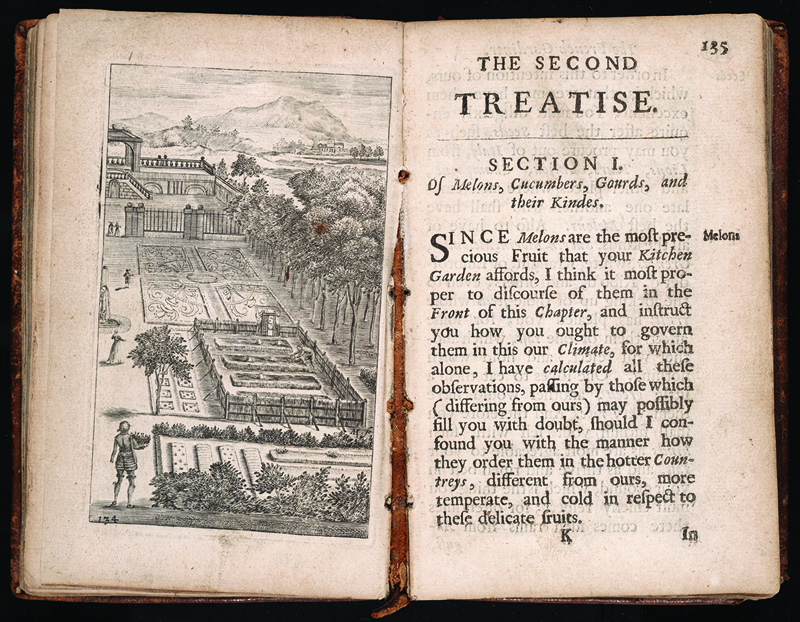
Changes to food culture began in the kitchen garden. At Versailles, Louis XIV acquired the services of Jean-Baptiste de La Quintinie (1626–1688), a gifted horticulturist who transformed the palace’s kitchen gardens between 1678 and 1683. De La Quintinie expanded the growing season of many vegetables and fruits using Italian techniques of enclosures and raised warm beds (Fig. 6). His work resulted in a proliferation of fruits and vegetables available for the royal kitchens; for instance, he cultivated more than forty different types of pears at Versailles, enabling the serving of fresh pears almost year-round. Gardeners all over Europe employed these methods, some becoming obsessed with growing tropical fruits such as pineapples and melons in northern climates. Cooks who did not have access to such fashionable ingredients resorted to clever ways of imitating them for the table. They delighted in fooling diners, creating edible forms that looked like one type of food but tasted of another, such as “mellons” made of sausage meat (see sidebar, p. 81).
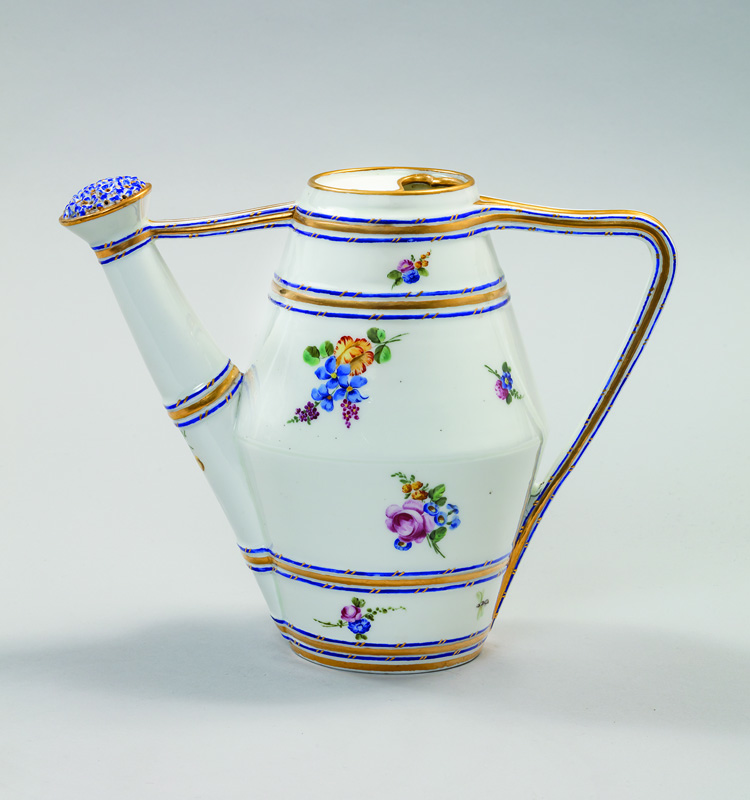
Diets of the wealthy in the 1600s and 1700s were not limited to the produce of farms and gardens. Long-established European trade in wine, olive oil, cheese, preserved meat and fish, and even pasta supplemented local foodstuffs. Exploration and colonialism expanded the horizons of trade to Asia and the New World, leading to increasing imports of new foods, such as turkey, tea, spices, and especially sugar. The quest for lucrative locations to grow sugar further fueled colonization and had devastating human consequences, with the enslavement and transportation of millions of Africans to toil on plantations in the Americas.
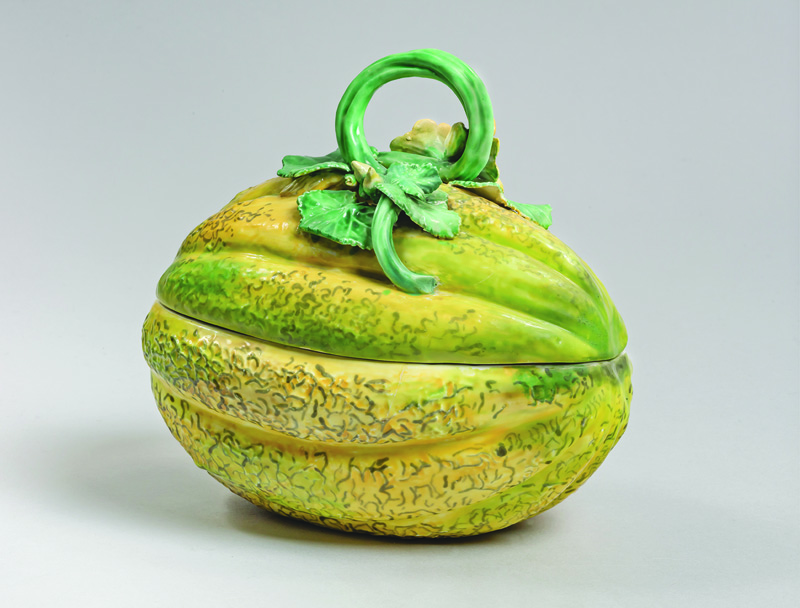
In the kitchen, technological advances enabled more sophisticated culinary techniques. Key was the widespread adoption, in the houses of the wealthy, of brick stoves with rows of hobs fueled by charcoal. These stoves enabled the temperature control necessary for sauces, central to the new French cuisine. Mechanized spits replaced manual operation. Cooks gave great attention to detail, providing instructions for cooking and presenting their food. Hannah Glasse advised, “Always be very careful that your greens be nicely picked and washed. . . . Most people spoil garden things by over-boiling them. All things that are green should have a little crispness, for if they are over-boiled they neither have any sweetness or beauty.”
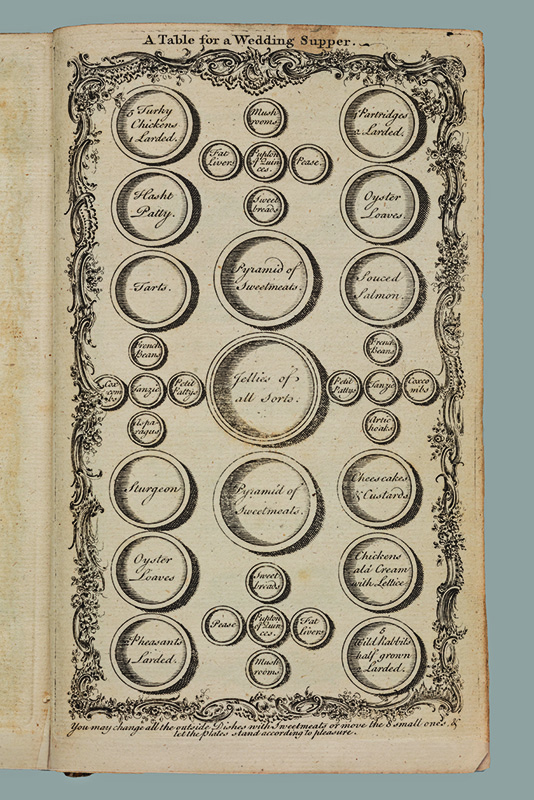
New philosophies for lighter, refined, and healthy eating were proposed in Europe during the Age of Enlightenment. It is remarkable to find that nouvelle cuisine, made famous in the 1970s by French chefs such as Paul Bocuse and Michel Guérard, had already appeared 230 years earlier! English scientist John Evelyn (1620–1706) proposed a vegetarian “Herby-Diet” in 1699, and in the 1760s Jean-Jacques Rousseau expounded it as his
philosophy. Rousseau advocated a simple, meatless diet based on fresh, local foods, believing that being closer to nature was healthier for body and character.
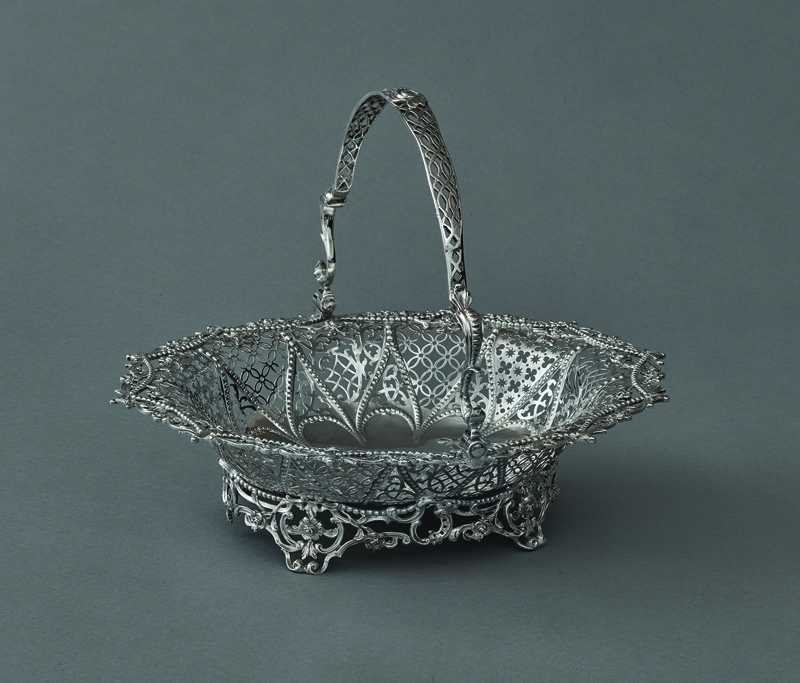
Along with the refinement of cooking came dramatic developments in the arts of the table. Meals were served in three or more courses à la française during this time. Depending on the event and the complexity of the meal, servants or members of the household arranged all the serving dishes in a symmetrical pattern on the table, course by course (Fig. 9). Even simple meals were presented in this manner. We now wonder how people of the period ate so much at grand dinners, but at the time, diners chose food only from the selection of serving dishes placed closest to them on the table. If they wished to eat something placed out of easy reach, a servant would fetch it. Dining in the French manner became the height of style all over Europe, and both the bourgeoisie and the upper classes adopted it with enthusiasm.
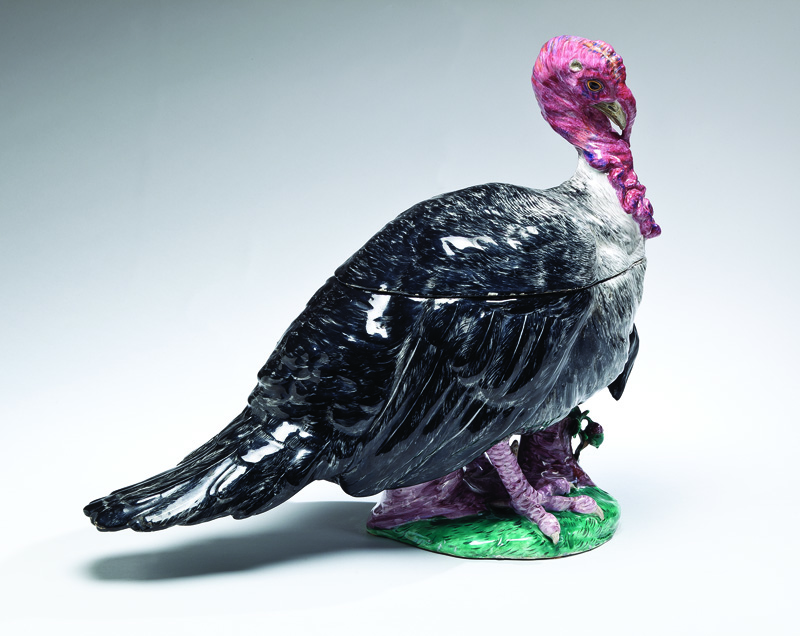
Whether diners ate from dishes of gold, silver, or pewter depended on their rank and financial status. Gold was restricted to kings and their immediate families; silver could be used by princes, the nobility, and members of the bourgeoisie whose wealth was sufficient; pewter, tin, or earthenware were used by everyone else. Faïence and porcelain were first used only for the dessert course because their surfaces were impervious to acidic fruit juices, but as the 1700s progressed, entire dinner and dessert services were made of porcelain—the new material of the age. Porcelain was a material that transcended rank and could be used by anyone with means.
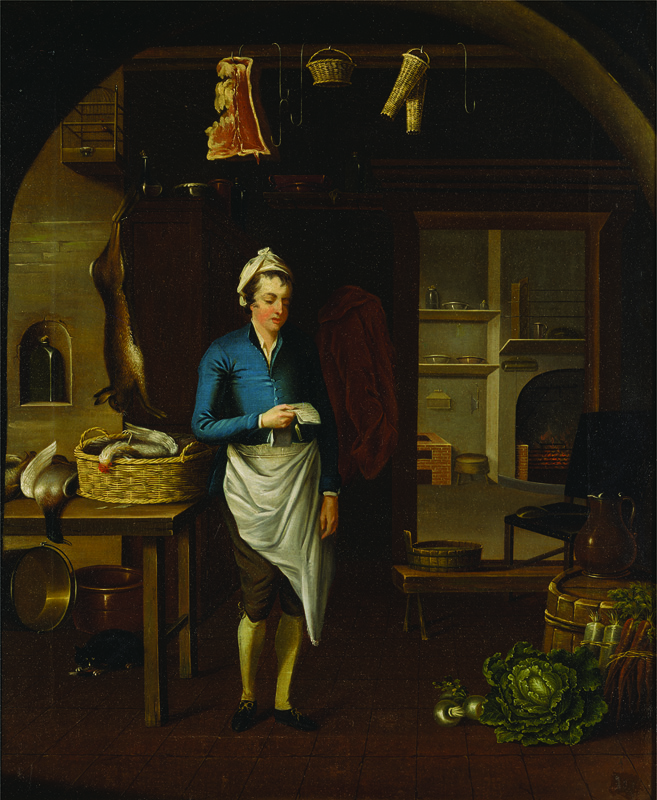
The combination of new foods and the formal presentation à la française led to the development of purpose-specific dishes for serving and eating. In the 1700s there was a veritable landslide of new vessels for both savory and sweet dishes that made dining both more elegant and more complicated. In 1742 Vincent La Chapelle suggested it was necessary to have twelve different sized and shaped dishes along with a range of elaborate tureens (Figs. 11,13) to serve his food—a sharp contrast to the four different sizes of simple circular dishes recommended by François Massialot thirty years earlier. This new development probably related to the impact of advances in cooking as well as to the rise of consumerism. Silver and ceramic manufacturers created new vessels for the most fashionable foods, such as cups for ice cream, sauceboats for savory or sweet sauces, and baskets for cakes and fruit (Fig. 10).
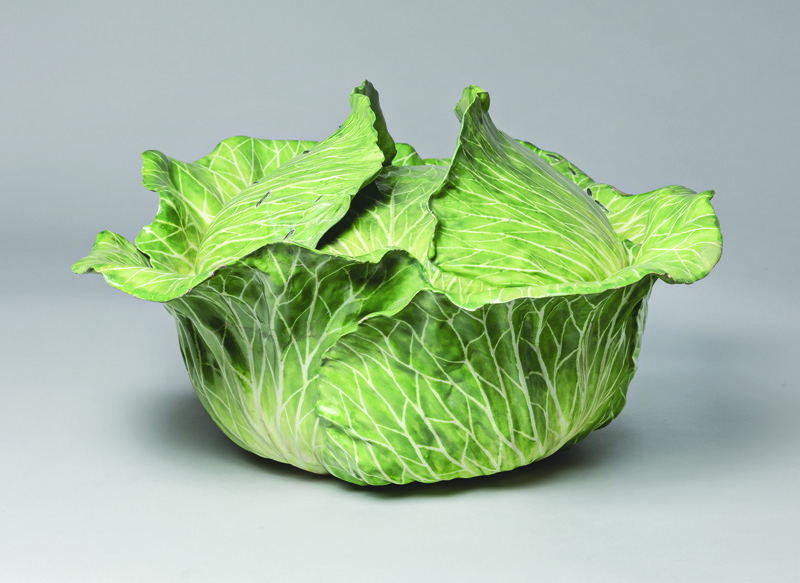
For a short time in the mid-1700s, there was a craze for naturalism. All kinds of forms, from teapots to tureens, were made to look like animals, birds, or vegetables. It is tempting to imagine how steam might emerge from the nostrils of a faïence boar’s-head tureen when it was filled with hot ragout, but it is unlikely that such complex pieces were actually used to serve food (Fig. 15).
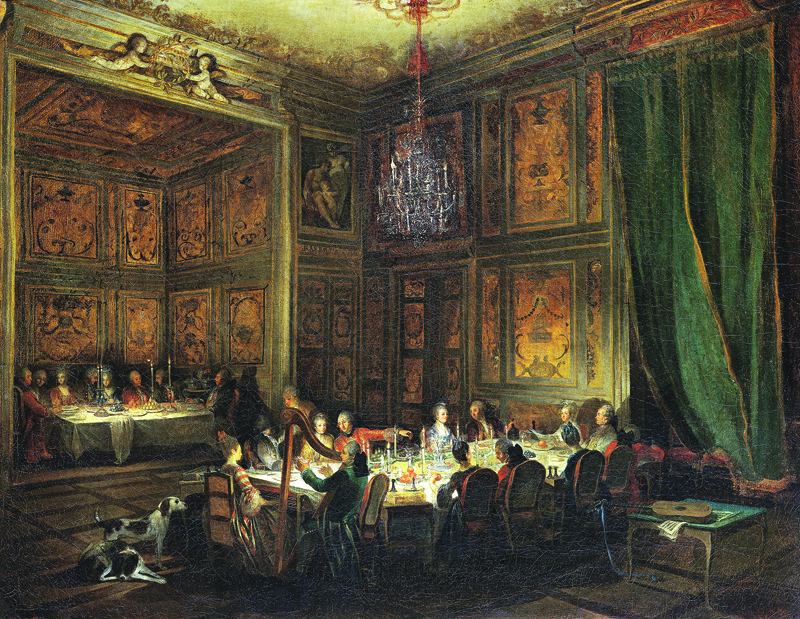
Times for eating varied from country to country and from city to countryside. The hours for fashionable dining by the wealthy became flexible during the 1700s in France. Dinner (dîner), the principal meal of the day, was served initially in the afternoon at around two o’clock, while supper (souper) or a light collation was taken late in the evening. As the century progressed, dinner gradually became a later event, and was often served by candlelight (Fig. 14). A new meal—luncheon—gradually became a midday feature. Supper was largely abandoned.
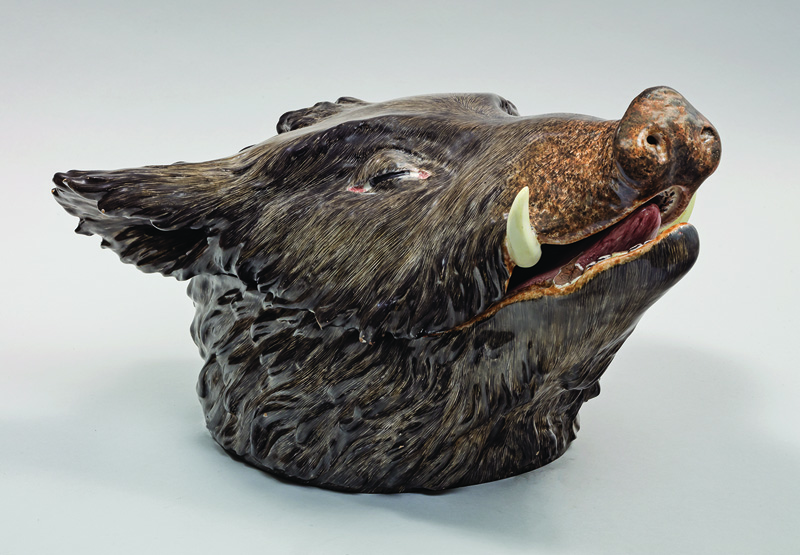
Just as dining habits have changed in recent times with the adoption of much more casual eating, so it was in the 1700s. The theatrical formality of the French court under Louis XIV in the 1600s led to a reactive desire for informality and intimacy during the reign of Louis XV in the following century. Intimate meals emerged as part of the new quest for privacy (Figs. 1, 16). Sometimes servants were dispensed with completely in the dining room, and diners served themselves to both food and wine.
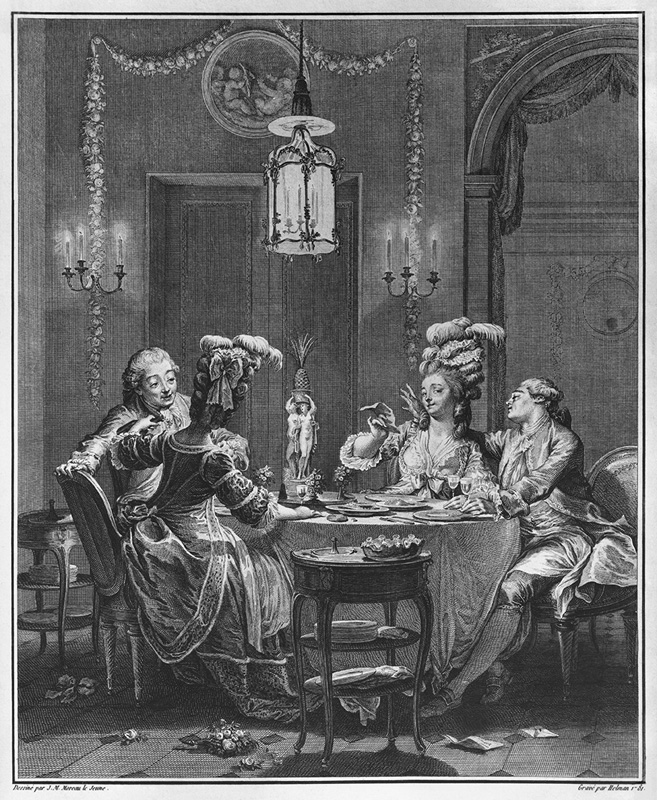
Toward the end of the 1700s, the first restaurants began to appear in Paris. Before then, upper-class travelers with letters of introduction could be invited to dine at the houses of local aristocrats, but others were obliged to eat at inns, where the table d’hôte (the host’s table) was offered at a communal table with little or no choice of food. Street vendors and cheap eating houses also provided cooked food to the working classes in large cities, offering local specialties from macaroni in Naples to meat pies
with dubious contents in London.
In many ways, food culture of the 1650s to 1790s was a precursor to modern times. Many of us have experienced a radical change in the availability of ingredients, with refrigeration and efficient transportation bringing foods from faraway parts of the globe. It is now possible to enjoy a breadth of international and ethnic cuisines largely unknown in the Western world fifty years ago. The philosophies of food have changed, often in favor of healthier and more moral choices. Even the way we eat has undergone a transformation as, once again, we favor less formal dining experiences. We have become obsessed with food and dining—modern foodies who reflect the passion for gastronomy that consumed gourmets in the Age of Enlightenment. The exhibition Savor: A Revolution in Food Culture and its accompanying cookbook, The King’s Peas, Delectable Recipes and Their Stories from the Age of Enlightenment, invite visitors to savor these connections while delighting in works of art, rare books, ceramics, silver, and glass from important public and private collections, alongside a small selection of contemporary ceramics and knitted art.
Savor: A Revolution in Food Culture originated at the Gardiner Museum, Toronto, and is on view at the Wadsworth Atheneum Museum of Art in Hartford, Connecticut, originally scheduled to run to May 25. This article was excerpted and adapted from the accompanying cookbook, The King’s Peas: Delectable Recipes and Their Stories from the Age of Enlightenment (Gardiner Museum and Arnoldsche Art Publishers, [2019]).
Bonus Recipe
A Melon of Minced Meat
from Elizabeth Moxon, English Housewifry, exemplified in above Four Hundred and Fifty Receipts, Giving Directions in most Parts of cookery…Printed for George Copperthwaite: Leeds, 1764, 9th ed., Appendix, no. 3.
To Make a MELLON
Make the leanest forc’d-meat [sausage] that you can, green it as near the colour of mellon as possible with the juice of spinage [spinach], as little of the juice as you can; put several herbs in it, especially parsley, shred fine, for that will help to green it; roll it an inch and a half thick, lay one half in a large mellon mould, well buttered and floured, with the other half the full size of the mould, sides and all; then put into it as many stew’d oysters as near fills it with liquor sufficient to keep them moist, and close the forc’d meat well together; close the melon and boil it till you think it is enough; then make a small hole (if possible not to be perceived) pour in a little more of the liquor that the oysters were stew’d in hot, and serve it up with hot sauce in the dish. It must be boiled in a cloth, and is either for a first or second course.
1 Nicolas de Bonnefons, Les delices de la campagne: Suitte du jardinier françois, ou est enseigné a preparer pour l’usage de la vie tout ce qui croist sur la Terre, & dans les Eaux (Paris: Pierre Des-Hayes, 1654), “Epistre aux Dames,” n.p. 2Giacomo Casanova, History of My Life, trans. Willard R. Trask, vol. 4 (New York: Harcourt, Brace and World, 1966), p. 39. 3 Etienne Léon de La Mothe-Langon (baron) and Marie Jeanne du Barry (comtesse), Memoirs of Madame du Barri, trans. [H. T. Riley], (London: H. S. Nichols, 1896), vol. 3, pp. 181–182. 4 Hannah Glasse, The Art of Cookery, Made Plain and Easy; Which far exceeds any Thing of the Kind yet published (Pierceton, IN: Townsends, 2018), p. 18. 5 John Evelyn, Acetaria: A Discourse of Sallets (London: printed for B. Tooke at the Middle-Temple Gate in Fleetstreet, 1699), p. 88. 6 The author gratefully acknowledges key scholarship that was fundamental to this article, the exhibition, and the accompanying publication, including Barbara Ketcham Wheaton’s Savoring the Past, The French Kitchen and Table from 1300 to 1789 (Philadelphia: University of Pennsylvania Press, 1983); Gilly Lehmann’s The British Housewife: Cookery-Books, Cooking and Society in Eighteenth-
Century Britain (Totnes, Devon: Prospect Books, 2003);Sara Paston-Williams’s The Art of Dining: A History of Cooking and Eating (Oxford: Past Times, 1996); and Susan Pinkard’s A Revolution in Taste, The Rise of French Cuisine (New York: Cambridge University Press, 2009).
Meredith Chilton is curator emerita of the Gardiner Museum in Toronto. She curated the exhibition Savor: A Revolution in Food Culture and is the author of The King’s Peas: Delectable Recipes and Their Stories from the Age of Enlightenment.
